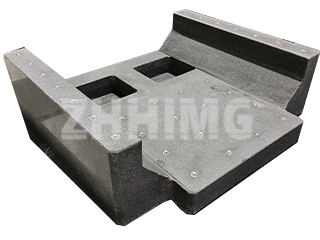Granite machine components—often referred to as granite bases, beds, or specialty fixtures—have long been the gold standard reference tool in high-precision metrology and industrial assembly. At ZHONGHUI Group (ZHHIMG®), our decades of experience in the design, manufacture, and servicing of these components have earned us a stellar reputation for meeting the most stringent accuracy requirements in the market. A granite component’s value lies in its superior natural properties: high hardness, dimensional stability, imperviousness to rust or magnetic fields, and a unique resistance to localized wear that does not compromise overall planar accuracy.
These components are not simple slabs; they are functional tools. They are routinely machined with through holes, threaded holes, T-slots, and various grooves to accommodate different fixtures and guides, transforming a standard reference surface into a highly customized, functional base for machinery. However, achieving this high degree of complexity requires that the auxiliary machinery used in their production meets equally stringent standards. What specific requirements must be met by the machinery that processes these high-precision granite components?
The Mandates for Precision Machining
The manufacturing process for a granite bed is an intricate blend of initial mechanical processing and final, meticulous hand-lapping. To ensure the final product meets the extreme accuracy required by our clients, the following demands are placed upon all auxiliary machining equipment:
Firstly, the processing machinery must itself be capable of maintaining excellent mechanical integrity and geometric accuracy. The quality of the raw material is only one part of the equation; the machinery must ensure that the machining process itself does not introduce errors. Before any official production run commences, all equipment must undergo a thorough trial operation. Full functionality and proper mechanical distribution must be verified to prevent the material waste and compromised precision that result from misalignment or malfunction.
Secondly, absolute cleanliness and smoothness are non-negotiable. All connecting points and surfaces of the mechanical parts must be free of burrs and blemishes. Any detectable residual material must be meticulously polished and removed. Furthermore, the environment of the machining equipment itself must be kept scrupulously clean. If any internal components exhibit rust or contamination, immediate cleaning is mandatory. This process involves thoroughly removing surface corrosion and applying protective coatings, such as anti-rust paint to internal metal walls, with severe corrosion requiring specialized cleaning agents.
Finally, the lubrication of mechanical parts surfaces is paramount. Before any processing begins, all necessary lubrication points must be fully serviced with the appropriate lubricants. Furthermore, during the critical assembly stage, all dimensional measurements must be rigorously and repeatedly verified. This meticulous double-checking process ensures that the finished granite component achieves the targeted accuracy levels demanded by our quality control policy: “The precision business can’t be too demanding.”
Granite: The Ideal Manufacturing Substrate
Granite’s dominance in this field is rooted in its geological composition. Primarily composed of feldspar, quartz (content typically 10%-50%), and mica, its high quartz content contributes to its renowned hardness and durability. Its superior chemical stability, with high silicon dioxide content (SiO2 > 65%), ensures its long-term resistance to environmental corrosion. Unlike cast iron, a granite base offers several distinct operational benefits: smooth, stick-slip-free movement during measurement, a low coefficient of linear expansion (meaning minimal thermal distortion), and the assurance that minor surface defects or scratches will not compromise the overall measurement accuracy. This makes the indirect measurement techniques facilitated by granite bases a highly practical and reliable method for inspection staff and production workers alike.
Post time: Nov-20-2025

